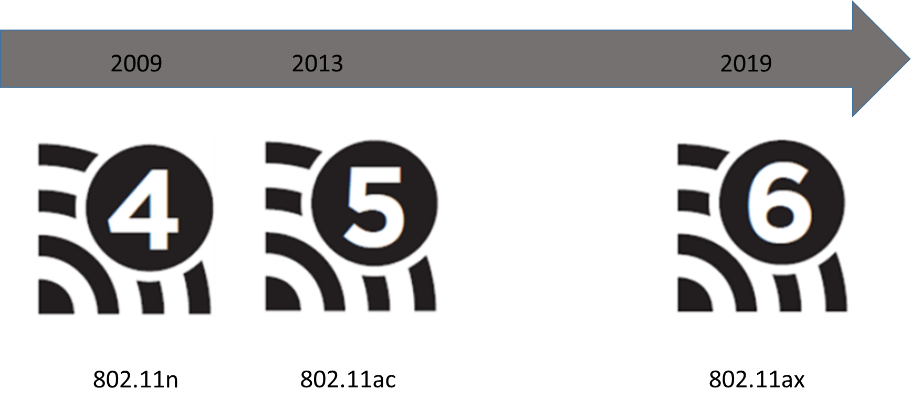Wi-Fi 6 (aka IEEE 802.11ax) is the latest iteration of the Wi-Fi network protocol. It is a significant upgrade over its predecessor 802.11ac (retroactively renamed Wi-Fi 5). This advanced network protocol allows for faster connection speeds with improved power efficiency and performance. Wi-Fi 6 allows access points (AP) to support more clients in dense environments, and offers a superior experience for users of typical wireless LAN networks. It also uses Target Wake Time (TWT) that schedules wake times to improve client battery life. In this article, we will discuss Wi-Fi 6 capabilities and router compatibility with older generation routers.
Wi-Fi Timeline
The Institute of Electrical and Electronic Engineers (IEEE) develops standards for computer networking and provides continuing innovations, maintenance, and amendments services for these standards. Wi-Fi is the colloquial term for Wireless Local Area Network (WLAN) technology and is a brand name used to market the 802.11 standards.
The 802.11 working group is responsible for writing and developing new WLAN standards. The working group oversees the work done by all the 802.11 "task groups." Each group is assigned a letter from the alphabet, and the term “802.11 alphabet soup” designates all the amendments edited by the multiple 802.11 task groups. Each amendment aims to enhance the 802.11 technology, with many enhancements vying for higher data rates and faster speeds (see Table 1).
|
Year |
Amendment |
Data rates |
2.4 GHz |
5GHz |
RF technology |
Radios |
|
1997 |
802.11 legacy |
1 and 2 Mbps |
ü |
|
DHSS and FHSS |
SISO |
|
1999 |
802.11a |
6-54 Mbps |
|
ü |
OFDM |
SISO |
|
1999 |
802.11b |
1,2,5.5 and 11 Mbps |
ü |
|
HR - DSSS |
SISO |
|
2003 |
802.11g |
6 - 54 Mbps |
ü |
|
OFDM |
SISO |
|
2009 |
802.11n |
up to 600 Mbps |
ü |
ü |
OFDM |
MIMO |
|
2013 |
802.11ac |
up to 6.93 Gbps |
|
ü |
OFDM |
MU - MIMO |
Table 1: 802.11 technology Timeline
The term multi-user (MU) implies that the transmissions between an AP and multiple clients can co-occur, depending on the supported technology.
What is Wi-Fi 6 (802.11ax)?
802.11ax is an IEEE draft amendment that enables high-efficiency operations in frequency bands between 1 and 6 GHz. It is a modified version of the 802.11 Physical (PHY) layer and the Medium Access Control (MAC) sublayer. The 802.11ax is also called High-Efficiency Wireless (HEW).
The Wi-Fi Alliance, a non-profit organization advocating the use of WLAN, has recently adopted a new generational naming convention for Wi-Fi technologies. The new naming scheme will help users differentiate between the various Wi-Fi technologies. It uses a numerical approach to identify Wi-Fi generations, where the numbers correspond to essential advancements. The 802.11ax technology is known by the generational name Wi-Fi 6 as it is a significant transition from previous versions of 802.11 technology. Figure 1 shows the new naming convention.

Figure 1: Generations of Wi-Fi
Wi-Fi 6 — More than just speeds and inputs
A Wi-Fi 6 implementation is highly configurable due to channel bandwidth, spatial streams, and multi-user signaling mechanisms. The lower end of the throughput range targets small handheld devices such as smartphones. The middle of the throughput range aims towards laptops, and the highest end of the throughput range targets outdoor and specialized applications where the device density is much lower when compared to indoors.
Wi-Fi 6 technology focuses on better use of the existing radio frequency medium. The goal is more efficient and improved 802.11 traffic management. Another notable Wi-Fi 6 change is that an access point (AP) can control the medium, and supervise downlink and uplink transmissions to many client radios. Besides these multi-user efficiency upgrades, Wi-Fi 6 (802.11ax) radios are backwards compatible with the 802.11/a/b/g/n/ac radios.
Table 2 shows examples of Wi-Fi 4, Wi-Fi 5, and Wi-Fi 6/6E configurations for targeting specific devices or applications.
|
|
Wi-Fi 4 |
Wi-Fi 5 |
Wi-Fi 6 |
Wi-Fi 6E |
|
Frequency bands |
2.4 GHz and 5GHz |
5GHz only |
2.4 GHz, 5 GHz |
6Ghz |
|
Channel size (MHz) |
20, 40 |
20, 40, 80, 80+ 80, and 160 |
20, 40, 80, 80+ 80, and 160 |
20, 40, 80, 80+ 80, and 160 |
|
Frequency multiplexing |
OFDM |
OFDM |
OFDM and OFDMA |
OFDM and OFDMA |
|
Modulation |
Binary Phase-Shift Keying(BPSK), Quadrature Phase Shift-Keying(QPSK), 16-QAM(Quadrature Amplitude Modulation), 64-QAM |
BPSK, QPSK, 16-QAM, 64-QAM, 256-QAM |
BPSK, QPSK, 16-QAM, 64-QAM, 256-QAM, 1024 QAM |
BPSK, QPSK, 16-QAM, 64-QAM, 256-QAM, 1024 QAM |
|
Max Data rate |
600 Mbps |
Up to 6.93Gbps |
9.6Gbps(1.5Gbps per device) |
9.6Gbps( 2.3Gbps per device) |
Table 2: Wi-Fi 4, 5, 6, and 6E comparison
Extending Wi-Fi 6 into 6 GHz
The industry identifies Wi-Fi devices operating at 6 GHz as Wi-Fi 6E. An important differentiator is the non-requirement for backward compatibility when using the 6 GHz frequency band for 802.11ax technology. Protection mechanisms are unnecessary as 802.11a/b/g/n/ac radios operate only on the 2.4 GHz or 5 GHz band.
Is My Old Router Compatible with WI-FI6/6E?
Routers that are older than approximately three years will not support Wi-Fi 6, and must be upgraded. WLAN vendors already sell Wi-Fi 6E APs in many different form factors. Wi-Fi 6 routers are compatible with devices dating back to the early 2000s, and these devices have radios for all three bands (2.4, 5, and 6 GHz). However, only the new Wi-Fi 6E client devices with 6 GHz radios can communicate with the 6 GHz radio in a Wi-Fi 6E AP. An older dual-frequency (2.4 and 5 GHz) smartphone communicates solely with the 2.4 or 5 GHz radio in a tri-band Wi-Fi 6E AP.
Most devices slated to sell in the next few years—including PCs, smartphones, tablets, and TVs—will be Wi-Fi 6-certified.
